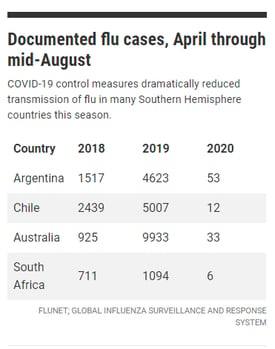Precautionary measures used to reduce the spread of COVID-19, like travel restrictions, facilities closures, increased cleaning and disinfection, social distancing, and mask-wearing, have all but stopped the flu virus from spreading in countries in the Southern Hemisphere. Argentina, South Africa, and New Zealand have reported an unexpected drop in influenza and other seasonal respiratory viral infections in the past two months.
Why does it matter?
This could be good news for countries in the Northern Hemisphere, as flu season is just around the corner. Health experts often look to the Southern Hemisphere's flu season infection numbers as a predictor for the Northern Hemisphere's upcoming flu season.
As an example, Australia has documented 33 flu cases this year between April and August, while last year during the same period, it recorded 9,933 infections.
Chile has documented 12 flu cases in the same time period. Last year during flu season, it recorded 5,007 infections, according to Science Magazine.
Will the U.S. have lower cases of the flu?
Sylvain Aldighieri, the deputy director of the Department of Health Emergencies at the Pan American Health Organization, stated that without the strict COVID-19 controls, he thinks the number of flu infections would have been at normal levels in the Southern Hemisphere.
Since there were fewer cases in the south, that could mean fewer infection particles will have the opportunity to spread north.
However, if Northern Hemisphere countries become lax on their closures and disinfection methods, and fewer people are sanitizing their hands, social distancing, or wearing masks, the flu will spread much more readily than it has in the south, warns virologist John McCauley, director of the Worldwide Influenza Centre at the Francis Crick Institute.
How can FM’s plan for flu season?
Luckily, many of the same disinfectants that eliminate the SARS-COV-2 virus in facilities and help keep your buildings COVID-clean, can also be used to combat the flu virus and other respiratory infection germs. Since these steps for cleaning and disinfecting for health are already being implemented at facilities in the Northern Hemisphere, as long as those measures continue through the fall and winter months, it will help reduce the potential spread of all germs.
Review the best ways to operate effectively with Flagship's new Healthy Workplace Guide to Stay Open Responsibly.
This information and data could prove as good news for the U.S. and Europe. Many public health experts have worried about the increased strain hospitals and clinics may be under if multiple viral respiratory infections are occurring simultaneously in the fall and winter months. Experts feared the increase in seasonal pathogens could overwhelm hospitals and cause serious illness in young children and the elderly.
The one negative is that since the Southern Hemisphere hasn’t had many cases, researchers have little evidence about how COVID-19 might influence the course of a flu outbreak. According to Science Magazine, beyond overwhelming hospitals and clinics, the big concern is coinfection—people getting COVID-19 and flu at once, says Ian Barr, deputy director of the World Health Organization Collaborating Centre for Reference and Research on Influenza in Melbourne, Australia.
But the consequences of coinfections are still hypothetical. Since there have been so few cases of SARS-CoV-2 occurring at the same time as other viral infections, the risks haven’t been thoroughly studied.
Are there additional precautionary measures?
A potential benefit of the popularity of COVID-19 information is that the increase in knowledge about respiratory viral infections may encourage more individuals to become vaccinated for the flu virus well ahead of peak times in the season. According to the CDC, they are planning ahead for just that. For the upcoming flu season, they expect to have a record-setting 194 million to 198 million doses—a 20 million–dose increase from last year.
Each year, most facilities increase their high-touch disinfection and sanitation within their facility to help reduce the spread of flu germs and other respiratory viral infections. If there is one silver lining, the new precautionary measures that individuals and facilities are taking to reduce the spread of COVID-19 seem to be doing double duty and also reducing the spread of additional contagious viruses.
Flagship's customizable approach to your facility's needs will help you protect employees and your assets now and into the future.
Email a facilities expert today and get the help you need to keep your facility healthy and safe.






Leave a Comment